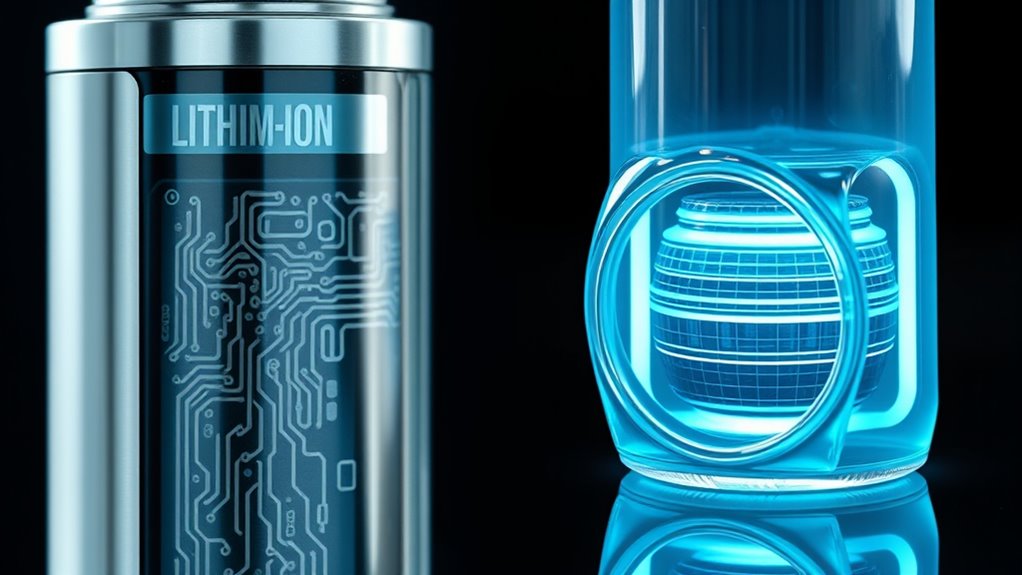Li-ion batteries use liquid electrolytes, which can pose safety risks like fires and leaks, while solid-state batteries replace this with solid electrolytes, making them safer, more stable, and capable of higher energy density. They can charge faster, last longer, and operate safely at higher temperatures. However, they’re more expensive and face manufacturing hurdles now. Exploring further reveals how these differences shape future tech and industry trends.
Key Takeaways
- Lithium-ion batteries use liquid electrolytes, while solid-state batteries employ solid electrolytes, affecting safety and performance.
- Solid-state batteries offer higher energy density and faster charging capabilities compared to traditional lithium-ion batteries.
- Solid electrolytes are non-flammable and thermally stable, reducing fire risks associated with liquid electrolytes.
- Lithium-ion batteries currently have lower manufacturing costs, but solid-state batteries promise longer lifespan and enhanced safety.
- The industry is shifting toward solid-state technology with upcoming commercial models expected by 2025–2027.
Understanding the Basic Structures of Lithium-Ion and Solid-State Batteries
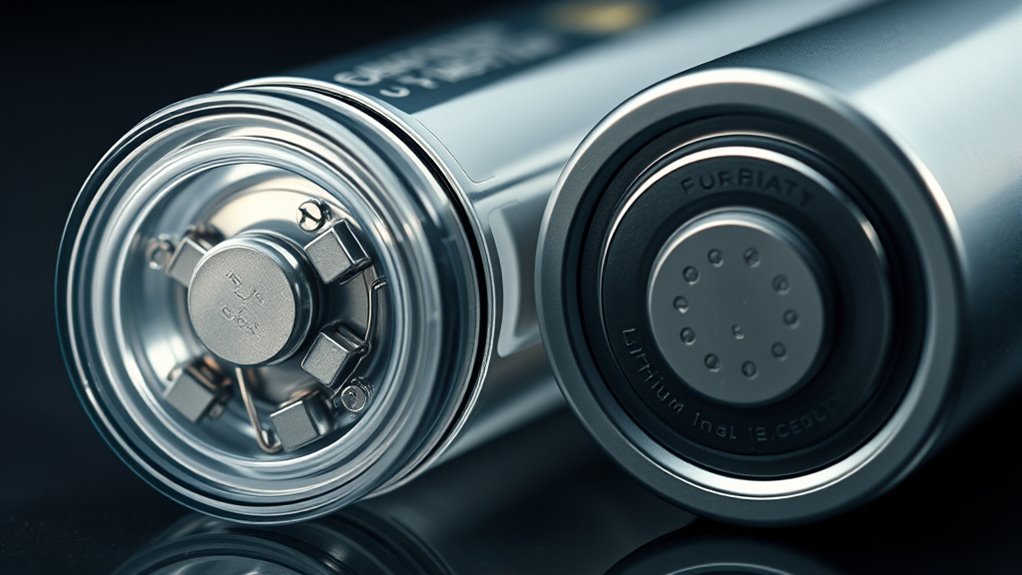
To understand the basic structures of lithium-ion and solid-state batteries, it’s important to see how they differ in their components.
Understanding the key differences in components reveals how lithium-ion and solid-state batteries operate.
In lithium-ion batteries, a liquid electrolyte, usually a lithium salt in organic solvents, facilitates electrolyte conduction. Lithium ions migrate through this liquid electrolyte during charge and discharge, moving between the graphite anode and lithium metal oxide cathode. Self Watering Plant Pots help illustrate how different materials can influence the movement of substances within a system.
The electrode interface in this setup involves a liquid-electrode contact, which impacts stability.
Conversely, solid-state batteries replace the liquid electrolyte with a solid electrolyte, such as ceramic or polymer materials, allowing ions to migrate through a dense, solid medium. This eliminates the separator and creates a solid-solid electrode interface. The solid electrolyte enhances safety and can enable higher energy densities compared to traditional liquid electrolytes.
These structural differences influence how efficiently ions move and how stable the overall battery remains during operation.
The Role of Electrolytes in Battery Performance and Safety
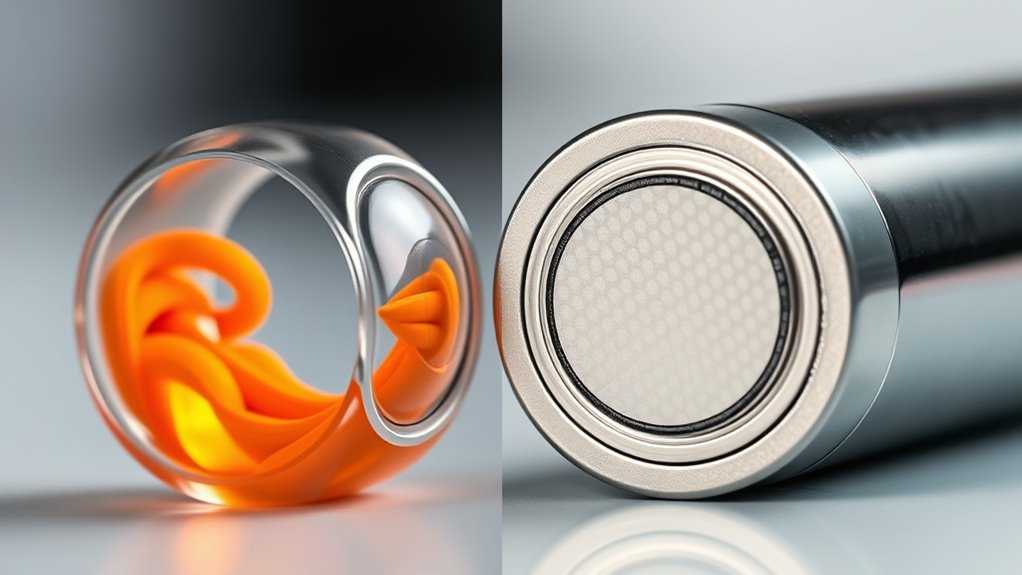
Electrolytes are vital for determining a battery’s performance and safety. Moving from liquid to solid electrolytes improves thermal stability, reduces fire risks, and enables faster charging. Additionally, advancements in battery technology continue to enhance overall efficiency and safety features. For example, solid-state batteries can offer higher energy densities and longer lifespans compared to traditional lithium-ion cells.
Electrolyte Composition Impact
The composition of electrolytes plays an essential role in determining both the performance and safety of batteries. In solid-state batteries, solid electrolytes made from ceramics or polymers like sulfides or oxides offer increased thermal stability and are non-flammable, reducing safety risks. Electrolyte composition also influences the durability and lifespan of the battery, ensuring consistent performance over time. The electrolyte composition directly impacts ionic conductivity; solid electrolytes with conductivities over 10 mS/cm enable fast charging and high performance. Unlike liquid electrolytes, which are flammable and pose safety concerns, solid electrolytes enhance thermal stability, making batteries safer and more reliable. Penetration testing techniques Shifting to solid electrolytes in solid-state batteries not only improves safety but also allows for more compact and energy-dense designs. Additionally, the material properties of electrolytes can affect their ability to withstand mechanical stresses during operation, especially under cybersecurity threats that target battery management systems. Moreover, advancements in material science are crucial for developing electrolytes that can withstand various operational stresses and extend battery lifespan. Overall, electrolyte composition is essential for optimizing both performance and safety in next-generation battery technologies.
Safety and Thermal Stability
Solid electrolytes substantially enhance battery safety and thermal stability, addressing key concerns associated with traditional liquid electrolytes. Unlike flammable electrolytes, solid electrolytes are non-flammable, greatly reducing the risk of thermal runaway and fires. Their high thermal stability allows solid-state batteries to operate safely at temperatures up to 100°C without degradation or safety issues. This stability prevents leaks or evaporation, which are common in lithium-ion batteries and can pose safety hazards. The non-flammable nature of solid electrolytes ensures safer charging, discharging, and resilience during physical damage or accidents. Additionally, the integration of natural materials can further improve the environmental sustainability of these batteries. The development of AI security technologies in manufacturing processes can also enhance quality control and safety standards. Moreover, understanding the role of electrolytes in battery performance is essential for optimizing safety features and overall efficiency. Implementing advanced thermal management strategies can further improve the safety and lifespan of solid-state batteries. Advances in material innovation are continuously expanding the capabilities and safety features of solid electrolytes. Overall, the improved safety profile and thermal stability of solid electrolytes make solid-state batteries ideal for high-demand applications like electric vehicles and aerospace, where managing high temperatures and ensuring safety are critical.
Conductivity and Charge Rate
While solid electrolytes considerably improve safety and thermal stability, their ionic conductivity remains a key factor influencing battery performance. Higher ionic conductivity allows lithium-ion batteries to achieve faster charge rates by enabling efficient ion transfer. Liquid electrolytes in lithium-ion batteries have high ionic conductivity, supporting rapid charging but posing safety risks like flammability. Solid electrolytes, such as ceramics or polymers, typically have lower conductivity, limiting charge speed. However, material engineering is improving their ionic conductivity to match or surpass liquid electrolytes. The table below compares their properties:
| Aspect | Liquid Electrolytes | Solid Electrolytes | Impact on Charge Rate |
|---|---|---|---|
| Ionic Conductivity | High | Lower (but improving) | Faster with higher conductivity |
| Safety | Flammable, safety risks | Safer, thermally stable | Better safety but may limit speed |
| Materials | Organic solutions | Ceramics or polymers | Ongoing improvements for performance |
| Charge Rate | Rapid charging possible | Improving but still limited | Key to advancing solid electrolyte tech |
Comparing Energy Density and Power Output
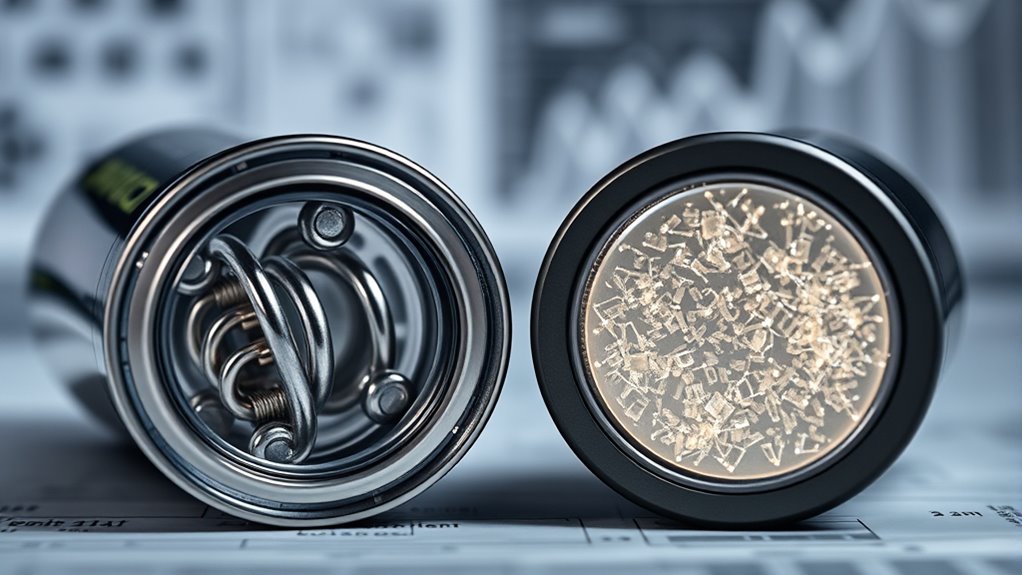
When comparing energy density and power output, solid-state batteries stand out for their significant improvements over traditional lithium-ion designs. They can reach energy densities of up to 400 Wh/kg, nearly doubling the roughly 250 Wh/kg of lithium-ion batteries. This higher energy density means you’ll enjoy longer driving ranges and better performance. Additionally, emerging research suggests that advancements in battery technology could further enhance these capabilities, making solid-state batteries even more competitive. Their superior ionic conductivity allows for higher power output, enabling faster charging—some models reach 80% in just 10-15 minutes. The increased power output also supports high discharge rates, making solid-state batteries ideal for demanding applications. Furthermore, ongoing innovations in sustainable materials are expected to improve the environmental footprint of these batteries, aligning with eco-friendly travel initiatives. Moreover, the development of advanced electrolytes promises to further boost both safety and efficiency in future designs.
Lifespan and Degradation Factors
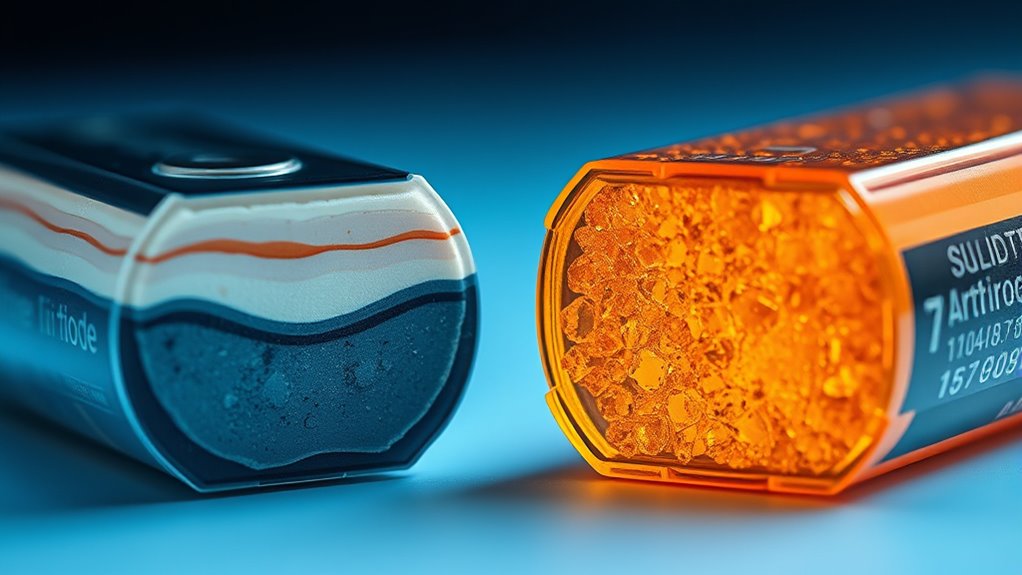
Understanding how batteries degrade over time is essential if you want reliable performance. Lithium-ion batteries typically last around 2000 cycle lives before significant capacity fade, while solid-state batteries can endure 1000–1500 cycles thanks to their solid electrolytes. Degradation occurs through electrolyte decomposition, electrode breakdown, and dendrite formation, which reduce efficiency. Solid electrolytes in solid-state batteries limit dendrite growth and chemical reactions, slowing degradation and extending lifespan. Factors like high temperatures, rapid charging, and deep discharges accelerate capacity fade in lithium-ion types, but solid batteries show better thermal stability. Electrolyte decomposition is a key process in battery aging that impacts overall longevity.
Safety Features and Risks
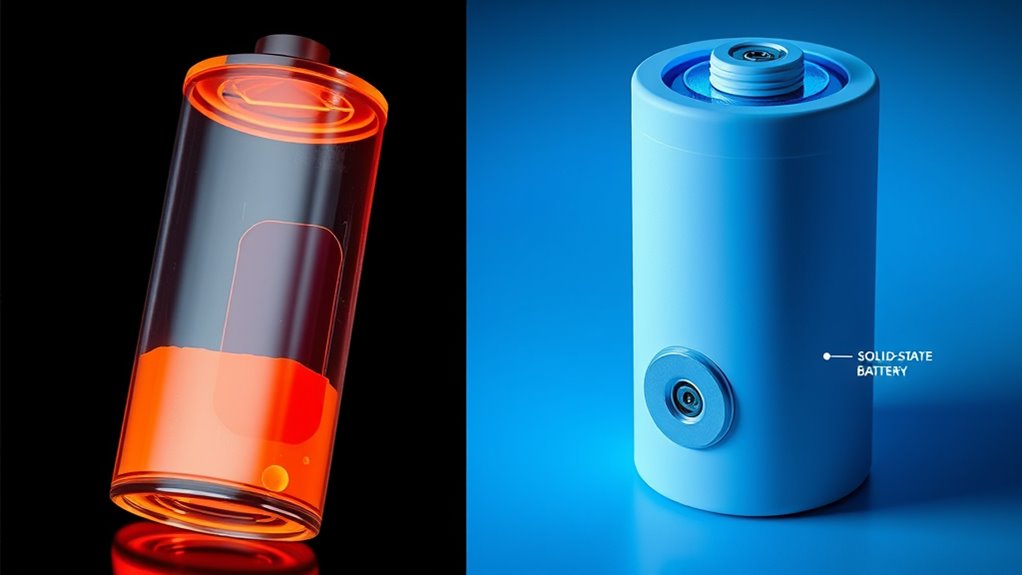
While solid-state batteries are generally safer, overheating risks still exist if they’re damaged or improperly managed. Unlike lithium-ion batteries, which contain flammable liquid electrolytes that can ignite, solid-state designs use non-flammable solid electrolytes for added safety. However, understanding their thermal stability and potential hazards is vital for ensuring safe operation in various applications. Additionally, ongoing research into battery volatility aims to improve safety protocols and reduce overheating risks further. Ensuring consumers are educated about credit card security measures can also help mitigate cyber-related risks associated with new battery technologies. Proper handling and understanding of necessary cookies can help improve the safety and efficiency of these advanced energy systems.
Overheating Risks Remain
Although solid-state batteries offer improved safety over traditional lithium-ion cells, they aren’t entirely risk-free. Their solid electrolytes are non-flammable and more thermally stable, reducing overheating risks and the chance of thermal runaway. However, issues like dendrite formation and interface instability can still cause localized heating, posing safety concerns. Additionally, the use of vetted home theater projectors as an analogy highlights the importance of thorough safety considerations in advanced battery technology. High temperatures above 60°C can degrade solid electrolytes over time, increasing overheating risks if thermal management isn’t properly maintained. External factors or internal defects can also trigger overheating incidents, despite the inherent safety advantages. Proper thermal management strategies are essential to prevent risks associated with overheating and to maintain the integrity of the battery’s safety features. Furthermore, ongoing research into dog names underscores the significance of selecting appropriate identifiers for different breeds, which can sometimes influence perceptions of safety and reliability in various contexts.
Flammable Liquid Electrolyte
Flammable liquid electrolytes in lithium-ion batteries present a substantial safety risk, especially if the battery gets damaged or mishandled. These liquid electrolytes, made of volatile organic solvents, are flammable and can ignite if overheated or short-circuited. When this happens, it can trigger thermal runaway, causing rapid temperature increases and potential fires. About 80% of battery-related fires in electric vehicles are linked to these flammable electrolytes. To manage this fire risk, manufacturers implement complex safety features and cooling systems. However, these measures add complexity and cost. Unlike solid-state electrolytes, which are non-flammable, liquid electrolytes considerably compromise safety, making the risk of fire a critical concern in lithium-ion battery design and usage. Additionally, floating on water safety protocols are essential in emergency response situations involving battery fires to prevent water from spreading flammable liquids.
Enhanced Thermal Stability
Have you ever wondered why solid-state batteries are considered safer than traditional lithium-ion ones? It’s because their solid electrolytes offer enhanced thermal stability. Unlike liquid electrolytes, solid electrolytes are non-flammable and resist overheating, reducing the risk of thermal runaway and fires. They maintain structural integrity at higher temperatures (up to 100°C), avoiding decomposition or combustion. This inherent safety feature makes solid-state batteries more reliable, especially in demanding environments. Here’s a quick comparison:
| Feature | Lithium-Ion Batteries | Solid-State Batteries |
|---|---|---|
| Electrolyte Type | Liquid | Solid |
| Flammability | Flammable | Non-flammable |
| Thermal Stability | Moderate | High |
| Risk of Thermal Runaway | Higher | Lower |
| Safety in High Temperatures | Limited | Enhanced |
This improved safety profile is a key advantage of solid-state batteries.
Manufacturing Challenges and Cost Implications

Manufacturing solid-state batteries presents significant challenges that drive up costs and complexity. The process demands advanced manufacturing techniques like vacuum sealing and high-precision assembly, which increase production difficulty.
The ceramic electrolyte used in these batteries is brittle, leading to higher breakage rates and defects, raising overall costs. Currently, production costs range from $800 to $1200 per kWh, far above the $100 to $150 per kWh for mature lithium-ion batteries.
Scaling up manufacturing is particularly tough because it requires specialized equipment and strict quality controls to ensure electrolyte integrity. Ongoing research aims to develop more cost-effective, scalable fabrication methods, with hopes of reducing prices below $200 per kWh by 2028.
These challenges remain key barriers to widespread adoption.
Applications and Future Potential of Each Battery Type
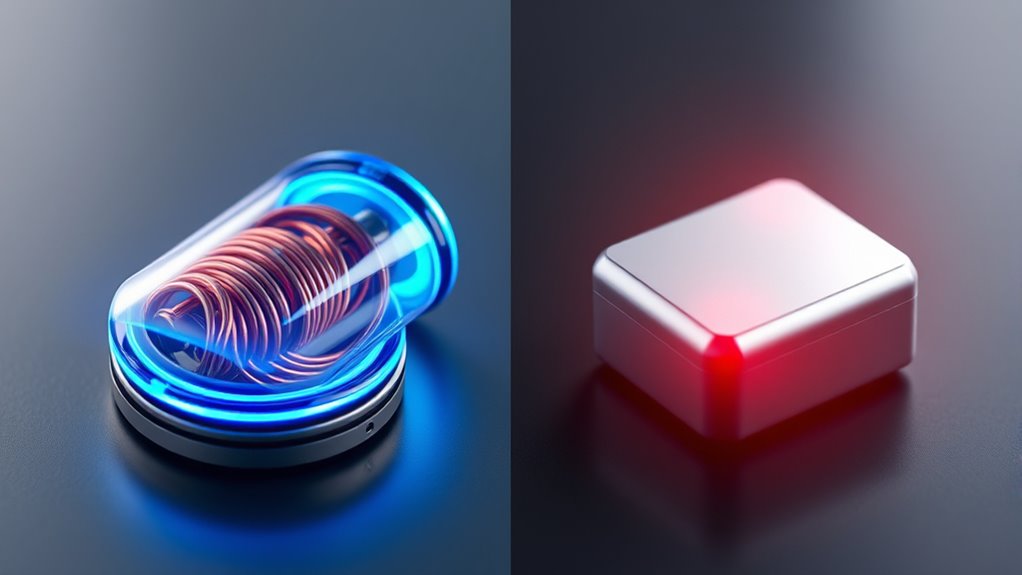
Solid-state batteries are poised to transform the high-end electric vehicle market by 2030, thanks to their superior energy density and enhanced safety features. They’re ideal for applications like grid storage and portable electronics, offering faster charging, longer lifespan, and better thermal stability. As technology advances, prototypes now demonstrate over 1,000 charge cycles with energy densities nearing 400 Wh/kg. Commercial deployment around 2026-2027 is expected, led by companies like Toyota and QuantumScape. While costs remain high today, innovations in manufacturing processes aim to make solid-state batteries more affordable, potentially surpassing lithium-ion batteries by the late 2020s. Their future lies in powering electric vehicles, grid storage, and consumer electronics with greater efficiency and safety.
| Application | Future Potential |
|---|---|
| Electric Vehicles | Dominance in high-end markets by 2030 |
| Grid Storage | Reliable, scalable energy solutions |
| Portable Electronics | Faster charging, longer lifespan |
| Broader Consumer Use | Safer, more durable energy storage |
Emerging Innovations and Market Trends
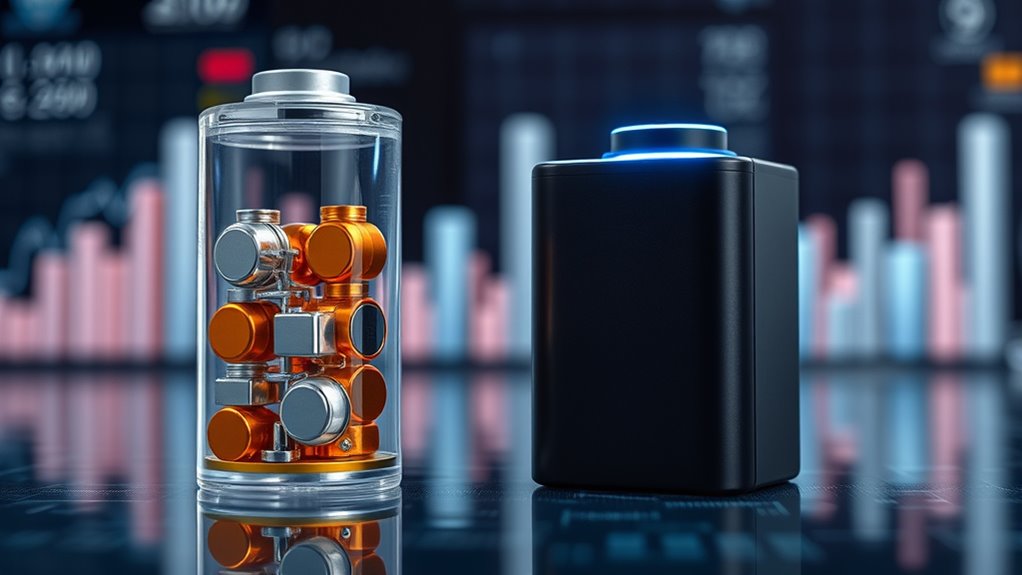
Emerging innovations are driving significant progress in solid-state battery technology, with researchers focusing on enhancing interface stability and extending cycle life. These advancements aim to increase energy density, making solid-state batteries more competitive with lithium-ion counterparts.
Market trends show a projected rise in solid-state batteries’ market share, reaching over 30% in premium EVs by 2035. Industry leaders like Toyota and QuantumScape plan to start commercial production between 2025 and 2027, signaling imminent market entry.
Although current manufacturing costs are high—$800 to $1200 per kWh—they’re expected to drop below $200 by 2028. As innovations address interface stability and durability, solid-state batteries will gradually complement existing lithium-ion technology across various sectors, shaping the future of energy storage.
Frequently Asked Questions
What Are the Disadvantages of Solid-State Lithium Batteries?
You should know that solid-state lithium batteries have several disadvantages. They cost more to produce, often over $800 per kWh, making them less affordable.
You might also encounter slower charge and discharge rates due to interface and grain boundary resistance. Their brittle ceramic materials can crack easily, reducing durability.
Additionally, achieving stable solid-solid interfaces is tough, which can cause safety issues like dendrite growth and limit their cycle life to around 1000 cycles.
What Is the Problem With Solid-State Batteries?
You might find that solid-state batteries face several issues. Interface resistance can slow down charging and shorten cycle life.
Manufacturing is complex and costly, making large-scale production tough.
The brittle ceramic electrolytes risk cracking over time, and maintaining stability at high voltages remains challenging.
Although dendrite formation is less common, it can still cause internal shorts.
These problems hinder widespread adoption despite their potential benefits.
Which Is Better Solid-State Battery or Lifepo4 Battery?
Think of choosing a battery like picking a vehicle: solid-state batteries are like sports cars—faster, more powerful, with higher energy density, perfect for long trips.
LiFePO4 batteries are more like sturdy trucks—safer, reliable, and cost-effective for everyday use.
If you want top performance and can handle higher costs, go solid-state.
For safety, affordability, and proven durability, LiFePO4 is your best bet.
Does Tesla Use Solid-State Batteries?
You’re wondering if Tesla uses solid-state batteries. Currently, Tesla relies on lithium-ion batteries, mainly focusing on improving their technology with innovations like the 4680 cells.
While other companies develop solid-state batteries, Tesla hasn’t announced plans to use them yet. They continue to invest in advanced lithium-ion tech, and industry analysts suggest they might explore solid-state options in the future.
But for now, solid-state batteries aren’t part of Tesla’s lineup.
Conclusion
As you consider the future of energy storage, which battery type will best power your needs—lithium-ion or solid-state? While lithium-ion batteries are proven and widespread, solid-state options promise safer, more efficient performance. The choice depends on your priorities—cost, safety, or longevity. Will advancements in technology tip the scales? Ultimately, staying informed helps you make smarter decisions about the batteries shaping tomorrow’s world.
